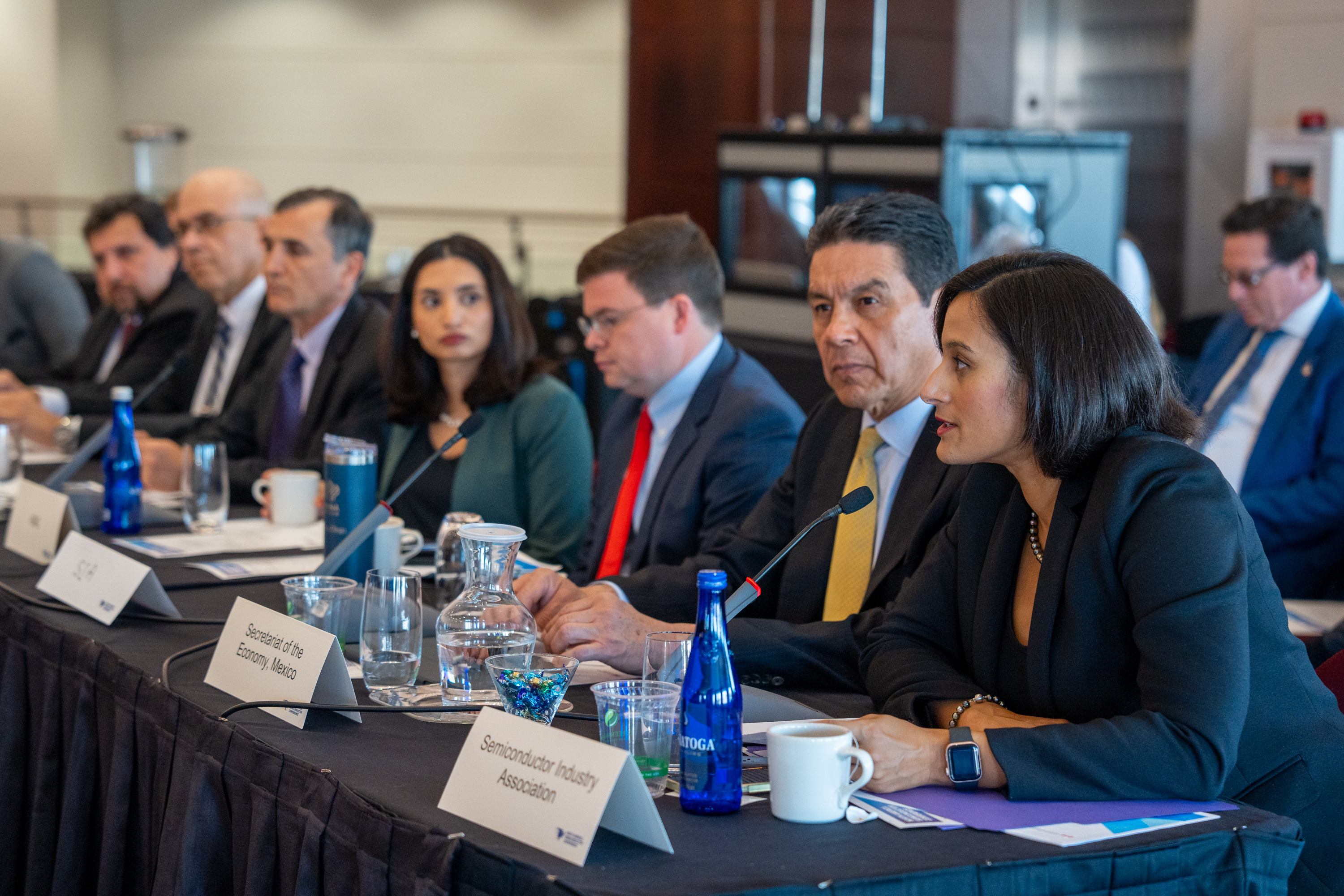ASU hosts first-ever tri-nation North America Semiconductor Conference

Industry, government and academic leaders from Canada, Mexico and the United States — including ASU faculty and staff — gather Thursday to discuss supply chain solutions and workforce development. Photo by Samantha Chow/ASU
Editor’s note: This story is featured in the 2023 year in review.
Arizona State University is hosting government and industry leaders from the U.S., Canada and Mexico at a high-level conference in Washington, D.C., this week to ensure North America’s future in the semiconductor industry.
ASU, in partnership with the Semiconductor Industry Association, is holding the first-ever North America Semiconductor Conference, where representatives from government, academia and industry will focus on aligning policy, expanding manufacturing, strengthening the supply chain and growing the workforce across the continent. Thursday’s events lean into industry and university representatives from the U.S., Canada and Mexico — including ASU faculty — and the government-focused Friday talks include cabinet members from all three countries.
“The logic of all this is that by working together, we can make products better and faster and at lower cost and this will help all three countries create the jobs of the future and build our economies from the bottom out,” said Max Hamilton, director for North American affairs at the National Security Council. He spoke during a press briefing about the conference on Wednesday.
“We’re including academia because we recognize that building a resilient supply chain is not something that government can do alone. Working together, we can build a more robust research ecosystem.”
Industry, academic and government leaders from Mexico, Canada and the U.S. convened in Washington, D.C., on Thursday for the North America Semiconductor Conference. Photo by Samantha Chow/ASU
Semiconductors are vital components of technology, in everything from phones to cars to defense weapons. The U.S. dominated semiconductor research and manufacturing until the 1980s, when most of it moved to Asia.
The COVID-19 pandemic highlighted the world’s dependency on Asia when supply chain disruptions led to critical shortages.
In 2022, the bipartisan CHIPS and Science Act was signed into law, releasing $52 billion over five years to help the U.S. regain its superiority in semiconductor research, manufacturing and supply chain logistics.
Arizona is going to be a major player in the initiative, thanks to big investments by companies such as Intel and the Taiwan Semiconductor Manufacturing Company, which is building two gigantic chip-fabricating centers in north Phoenix that will create 4,500 jobs, including 3,000 engineers. Several smaller companies are growing and relocating to the state as well.
ASU is an important factor not only for its location in a border state but also because it has the largest engineering school in the country, according to Kevin McGinnis, managing director for strategic technology initiatives at ASU.
“The challenges the industry faces are a significant shortage of workers and intense global competition,” he said.
A workshop on Thursday focused on workforce strategies.
“Our goal is to share lessons learned and best practices and identify concrete skills, and the specific types of skills, that the industry needs to fill to be competitive,” McGinnis said.
“We’ll think about how to fill gaps across all three countries, who’s doing it, who needs help and how we can expand those programs together.”
ASU has already been working on the issue, he said, including signing a memorandum of understanding with Mexico in November to expand workforce development there.
“We look at it very holistically,” he said, noting that many of the semiconductor jobs will be for technicians, and ASU has been working with the community colleges on job training for that. In addition, ASU established the New Economy Initiative Council — made of industry partners, academic experts and civic leaders — to address workforce development. ASU also provides hands-on training and access to leading-edge equipment at the MacroTechnology Works facility.
Jose Quiroga, director of global development for the Office of Global Outreach and Extended Education in ASU's Ira A. Fulton Schools of Engineering, moderates the discussion during the Future of North America’s Semiconductor Workforce (via Industry-Government-University Partnerships) session Thursday. Photo by Samantha Chow/ASU
The conference has a session on pinpointing the strengths and challenges of the U.S., Canada and Mexico all along the semiconductor supply chain.
That kind of mapping is important, according to Roberto Velasco Álvarez, chief officer for the North America unit at the Mexican Secretariat of Foreign Affairs.
“We need to understand exactly what each country is doing and how we can complement each other and not compete with each other,” he said.
“In the end, if we want to view this as a regional effort, the important thing is to think how we can be more competitive with other regions in the world and build on our strengths.
“Mexico believes that development of this industry is one of the most critical things we can do for our future.”
Michael Grant, assistant deputy minister for the Americas at Global Affairs Canada, said the conference focus will be on hard work.
“I think on the one hand it's really demonstrating North America as a cohesive competitive bloc in this particular and vital industry, but also it's about the practical,” he said.
“It's about bringing all of the stakeholders together and really rolling up your sleeves and getting practical about moving forward. It's about really getting down to business.”
U.S. Secretary of Commerce Gina Raimondo is leading the U.S. delegation at the conference, which will include representatives from Intel, Skyworks, IBM, IQE and TSMC, as well as officials from the governments, universities and technology industries in Canada and Mexico.
The Milken Institute will publish a Summary of Conclusions and Joint Action Plan as a follow-up to the conference.
More Law, journalism and politics

ASU experts share insights on gender equality across the globe
International Women’s Day has its roots in the American labor movement. In 1908, 15,000 women in New York City marched to protest against dangerous working conditions, better pay and the right to…

ASU Law to offer its JD part time and online, addressing critical legal shortages and public service
The Sandra Day O’Connor College of Law at Arizona State University, ranked 15th among the nation’s top public law schools, announced today a new part-time and fully online option for its juris doctor…

ASU launches nonpartisan Institute of Politics to inspire future public service leaders
Former Republican presidential nominee and Arizona native Barry Goldwater once wrote, "We have forgotten that a society progresses only to the extent that it produces leaders that are capable of…


